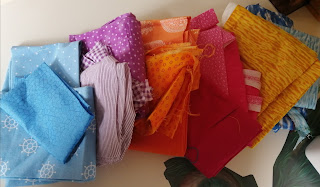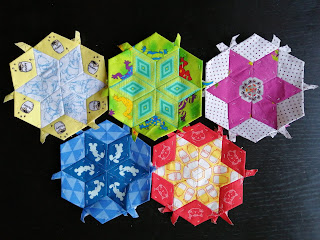The Threadhouse Virtual Retreat
Hello everybody!
I have just spent the weekend in a virtual sewing retreat! Organised by the lovely ladies of The Threadhouse, this is the third one they have organised during lockdown, but the only one I have attended. Here is my review of the experience.
The two days consisted of tutorials for three different projects: a Foundation Paper Piecing pincushion, an Improv Piecing mini quilt and clamshell purse. There was also a Facebook group for chatting and sharing pictures of our work and a Quilter's Question Time Watch Party in which the three hosts answered questions submitted to the group before the start of the event.
We were given a good supplies list in advance, as well as templates for the pincushion and purse. The theme for this retreat was Let's Go Mini, so all of the projects were small, and doable with quite small amounts of material. You could probably have done all of them with a single charm pack (pack of 5 inch precut squares) if you wanted. This was really good for me, as though I tend to avoid precuts smaller than a fat quarter, I have very little yardage and, as you have seen previously, lots of scraps, so I didn't need to buy any fabric for this. The only item that required more specialist materials was the clamshell purse, which needed felt (which I do have a small supply of) and plastic sheeting (which was doable with recycled fruit containers). I made my fabric choices and cut out what I could in advance of the first day, as I really wanted to try and get some finishes from this event. Here are my fabric pulls.
I have just spent the weekend in a virtual sewing retreat! Organised by the lovely ladies of The Threadhouse, this is the third one they have organised during lockdown, but the only one I have attended. Here is my review of the experience.
The two days consisted of tutorials for three different projects: a Foundation Paper Piecing pincushion, an Improv Piecing mini quilt and clamshell purse. There was also a Facebook group for chatting and sharing pictures of our work and a Quilter's Question Time Watch Party in which the three hosts answered questions submitted to the group before the start of the event.
We were given a good supplies list in advance, as well as templates for the pincushion and purse. The theme for this retreat was Let's Go Mini, so all of the projects were small, and doable with quite small amounts of material. You could probably have done all of them with a single charm pack (pack of 5 inch precut squares) if you wanted. This was really good for me, as though I tend to avoid precuts smaller than a fat quarter, I have very little yardage and, as you have seen previously, lots of scraps, so I didn't need to buy any fabric for this. The only item that required more specialist materials was the clamshell purse, which needed felt (which I do have a small supply of) and plastic sheeting (which was doable with recycled fruit containers). I made my fabric choices and cut out what I could in advance of the first day, as I really wanted to try and get some finishes from this event. Here are my fabric pulls.
The first project on the Saturday was mini Foundation Paper Piecing. Lynne Goldsworthy provided us with a beginner-friendly video tutorial talking us through the steps of piecing a little schoolhouse. It was very clear to follow, which was good, because I have only tried FPP once before. Here are the two blocks I made.
This was the only project I didn't finish. I took it very slowly, and had to unpick things a few times. At one point, I got very stressed about the chimneys not lining up nicely, but I calmed down after seeing that everyone found that difficult. I like my concept of turning the little houses into beach huts, and I do hope to finish this, but it has not made me fall in love with FPP. There are so many great FPP patterns out there, that I do want to enjoy the technique but somehow I just don't love it.
The Saturday afternoon project was a stack-and-slash improv log cabin technique provided by Karen Lewis (you can see a previous log cabin I made here). This technique was completely new to me, but I really enjoyed it.
First we had to stack our squares up, then chop them up and mix the fabrics around. I chose a monochrome colour scheme with little pops of colour in pink and yellow.
We could then peel off a layer at a time and sew them together into little blocks.
We made 3 batches of nine, making a total of 27 little blocks. My first batch of blocks was the most difficult as I was getting used to the technique. There are a total of four that I was unable to square up to the right size and I had to add extra strips to make them work. Which was how the yellow got introduced at this stage even though it wasn't in my original stack for this batch.
The other two batches went really smoothly. Having made the first block individually, I was able to do some chain piecing with the rest which meant they went together very quickly.
I then joined mine together to make a 5x5 square.
I finished it off with some machine quilting and black binding. This is actually the largest thing I have every machine quilted, as I do so much by hand. I know the diagonal lines are a simple choice, but I think I have done a good job of it and I am pleased.
I really, really like the end result of this one. I think the colours are really effective. I especially like the yellow, and I like that I was able to organise the pops of yellow to give a framing effect to the design. For something that is so improvised, I think that gives it an overall coherence. I very much enjoyed the technique and could definitely see me using it again it sometime. It does require a really sharp rotary cutter, though.
You may have noticed I made 27 blocks and the miniquilt only uses 25. I turned the two leftover blocks into a little pincushion.
Our Sunday project was a clamshell purse, with a tutorial provided by Jo Avery. This was very quick and easy. It was all handsewn, but as that is what I normally do, it didn't prove much of a challenge to me. Me being me, I used a fussy cut Star Wars fabric.
We made three 'lemons'.
And then joined them together to make the purse.
While this was fun, I didn't really get addicted to making them the way many others in the group did. In general, I have a lot of little purses, pouches etc already (I think anyone who sews a lot ends up with these), I know how to make more easily, and I don't find them very useful.
On Sunday afternoon, we had Quilter's Question Time session. This was a watch party of pre-recorded videos of the three hosts in conversation answering questions that had been submitted in advance. They talked about a wide range of subjects: following and breaking 'rules', quilting designs, choice of machines, choice of wadding, stash building, marking up fabrics, design software and their personal journeys to a career in the sewing industry. Follow-up questions and further details were provided through the comments. This was really interesting and it was good to see a variety of takes on the issues discussed.
Overall, I found the experience somewhat lacking. I very much enjoyed making the projects - they were well chosen for the amount of time. But part the reason I had signed up to it was because I have been feeling quite isolated from the quilting community recently - I have not been participating on Instagram as much as usual during lockdown - and I hoped to be able to reconnect with the community. While there were plenty of encouraging words and nice comments in the Facebook group, there wasn't really any conversation or interaction with the other quilters. And all the videos - including the Question Time - were pre-recorded so it didn't feel like getting a live experience. The real reason for the lack of connection is, in my opinion, that the group was too big. There were 120 of us. I would make the following suggestions for improving this.
1 Restrict the numbers. At a certain point, a group gets too big to make any human connections.
2 Divide the group into smaller sub-groups of no more than 10 people who could actually form a video chat group and talk to each other. Especially if restricting numbers is not financially viable. This could be done so people in the same time zone or speaking a different language were grouped together where possible. This would have been particularly useful for the evening session, where the whole point was to chat and connect with people and that wasn't happening. I get that it might be technically demanding and difficult to monitor, though.
3 There needed to be some conversation threads in the Facebook group. These could have been started by the admins, with topics of debate, e.g. favourite colour schemes, fave fabric designers/quilt designers, techniques you like best, your top tips for beginners. That way we could find out more about each other and find other like-minded sewists in the group.
4 Do the Question Time as Live Panel. Even if most the answers are pre-prepared.
My other main aim was improving my sewing machine skills, and I definitely feel I have done that. It's very quick work for me to get an entire mini quilt completed in less than two days and it does make me feel confident to start trying more machine piecing and quilting. So in that, the retreat was a success for me.
I also thought it was excellent value for money. It was £40 and with the amount of work the organisers had put into it, I did feel I got my money's worth. I would definitely go to a non-virtual retreat organised by them in the future (if I get the chance) and I might even do another virtual one if there are particular techniques or projects that appeal. I think, however, that making human connections might have wait until it is safe to do so in real life.
Thanks for reading!




















Comments
Post a Comment